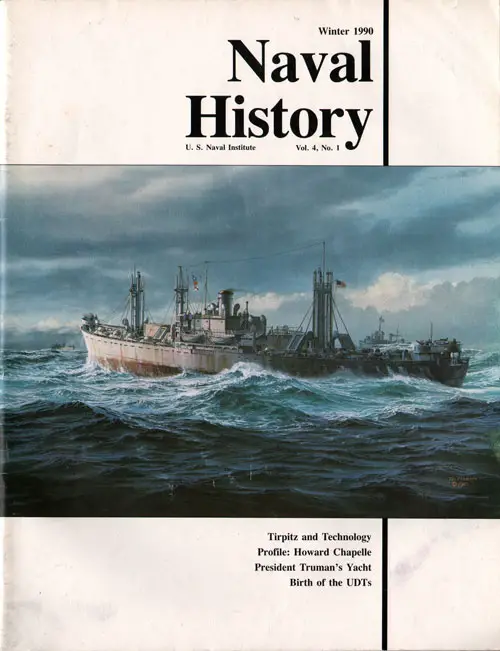Naval History - Winter 1990 - Battleship Floatplanes

Cover: The Liberty ship SS John VT. Brown leaves the East Coast outward bound for the Persian Gulf on her maiden voyage in this dramatic painting by Tom Freeman; the Sherman tanks chained to her decks are destined for Russia. Freeman has painted the ship as she looked in 1942, before she was modified to carry troops. The vessel is being restored to seagoing condition and will be homeported in Baltimore, Maryland. Chief Warrant Officer Theodore Dietz describes the ship's 48-ycar odyssey in the feature that begins on page 54.
Issue: Naval History, U. S. Naval Institute, Vol. 4, No. 1, Winter 1990.
The Winter 1990 issue of Naval History featured articles include: Uncle Joe’s Flying Column, Far East Odyssey of the UIT-24, Argentine Navy Revisited, Coast Guard's ‘Other’ Missions, and Tirpitz and Technology.
Features
13 Uncle Joe’s Flying Column
By Ivan Musicant
Colonel Joseph Pendleton’s strategy carried the day in one episode of the Banana Wars.
19 The Far East Odyssey of the UIT-24
By Charles Dana Gibson
German submariners coped with unfriendly Japanese and interned Italians in the closing days of World War II.
24 The Argentine Navy Revisited
By Rear Admiral Fernando A. Milia, AN (Ret.)
The continuing evolution of Argentina's seagoing service has been influenced by the navies of both friends and foes.
30 The Coast Guard's ‘Other’ Missions
By Donald L. Canney
Ice patrol, port security, and vessel safety are just a few of the Coast Guard's varied duties.
41 Tirpitz and Technology
By Gary E. Weir
An admiral's pervasive influence on advances in the German Navy early in the 20th century.
Departments
- Old Marine Corps: ‘The Fightin'est Marine’ 2
- In Contact 5
- Pictorial: Battleship Floatplanes 37
- Oral History: Draper Kauffman and the UDTs 45
- Oral History: President Truman’s Yacht 48
- The Old Navy: Last Cruise of the SS Central America 50
- Technical Report: New Life for a Liberty 54
- In Profile: Howard I. Chapelle 59
- Book Reviews 63
- In Progress 68
- Special: The Great Eclipse of 1878 73
- Museum Report: Jeremiah O'Brien: A Ship That Wouldn’t Quit 76
- In Focus 78
- Notebook 79
Publisher’s Page
In putting together a magazine called Naval History, we define “naval'’ broadly. In addition to the Navy itself, it also covers the other two sea services, and it deals with the merchant marine as well.
In this issue we salute the two surviving examples of World War II Liberty ships. Years ago, the Naval Institute published a book titled The Ugly Ducklings about the Liberties. Beauty, of course, is in the eye of the beholder.
Many people have considered the Liberty ships attractive—not for their physical appearance but for their cargo-carrying abilities and for the great contribution they made to victory in World War II.
Our Technical Report and Museum Report features focus on groups on both coasts that have preserved these workhorse ships of old so that they might be appreciated by new generations.
Ironically, some of the technology in the Liberties, such as the reciprocating steam engines, is even older than that used in some World War I ships. Dr. Gary Weir looks at the famous Admiral Allred von Tirpitz and his concern about innovations such as steam turbines for the German High Seas Fleet.
Germans of World War II are discussed in Charles Dana Gib son's article about U-boat men who served for a time with the Japanese in Italian submarines.
Our four-part series commemorating the Coast Guard’s bicentennial continues with a discussion of those “other” missions that don't Fit within the big three of war-fighting, search and rescue, and law enforcement.
For aviation buffs we share some rare color photos of battleship floatplanes from the period just before World War II. Ivan Musicant looks at Marine Corps intervention in the Caribbean in 1916.
The oral history excerpts contain recollections removed from the customary blue-water operations of the Navy.
Rear Admiral Donald MacDonald provides personal glimpses of President Harry Truman from his experience as skipper of the yacht Williamsburg. MacDonald won the job as a result of his top-notch record as a destroyer skipper in World War II.
Captain Frank Kaine describes the origins of the underwater demolition teams that contributed a great deal in World War II through their ability to do beach reconnaissance before amphibious landings and to blow up obstacles that would do harm to landing craft.
We were delighted to see so many individuals—old friends and new ones—at the Naval Institute reception at the Naval Academy history symposium in October.
Feedback and specific articles from the symposium will help shape future issues of Naval History. We also invite your participation at the upcoming Cactus Air Force symposium at the Nimitz Museum in Fredericksburg, Texas, in April and the carrier aviation symposium at the Naval Aviation Museum in Pensacola, Florida, in May.
Publication Information
The U. S Naval Institute is a private, self-supporting, nonprofit professional society, which publishes Proceedings magazine as a forum for the sea services, and professional books.
The Institute is not a part of the U. S. Government. Naval History is published quarterly by the U. S. Naval Institute. 2062 Generals Highway, Annapolis. MD 21401.
The opinions and assertions herein are the personal ones of the authors. Second class postage paid at Annapolis. MD, and at additional mailing offices.
Annual subscription rates: USNI member. $I2.00: USNI non-member. $24.00. International subscribers add $4.00. Copyright © 1990 U. S. Naval Institute. Copyright is not claimed for editorial material in the public domain.
POSTMASTER: Send address changes to Naval History. USNI. Circulation Department. 2062 Generals Highway. Annapolis. MD 21401 (ISSN: 1042-1920)
